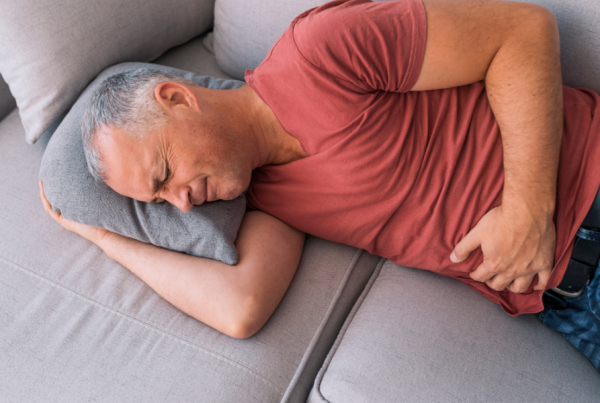Chronic Pain
Move Better. Live Fuller. Your Wellness Journey Starts Here.
Schedule a FREE Discovery Call!
What Is Chronic Pain?
Chronic pain refers to pain that is persistent, recurrent, or long-lasting, typically lasting longer than three to six months. “Chronic” refers to the length of time that the pain is experienced, and not the intensity—therefore, chronic pain can be anything from mild to severe. It can occur in any part of the body, and can affect the muscles, nerves, connective tissues, or other structures. The pain may come and go, or feel constant. Sensations of pain can vary, so chronic pain may be described as:
- Aching, throbbing, or shooting pain
- Pressure
- Tightness or stiffness
- Burning sensations
- Widespread or localized pain

Additionally, chronic pain can lead to other indirect symptoms, such as anxiety, fatigue, trouble sleeping, depression, and irritability. Unfortunately, chronic pain is often misunderstood. Some may think that chronic pain is only something severe such as a medical emergency, or that it only applies to certain parts of the body. As mentioned earlier, chronic pain can occur in any part of the body, and can vary in intensity.
Chronic pain can be attributed to a wide variety of factors, such as musculoskeletal problems, nerve compression, muscle dysfunction, and psychological causes. These factors aren’t limited to one area of the body! Some areas that chronic pain commonly occurs in includes:
- Head or neck
- Abdominals
- Lower back
- Joints such as the knees or hips
- Pelvis
- Perineal area / perineum
- Groin
- Urethra, bladder
- Rectum or anus
- Genitals (such as in the testicles, penis, vagina, or vulva)
- And other areas of the body
What Causes Chronic Pain?
Chronic pain can be caused by a wide variety of factors, some of which can be directly tied to other conditions. Chronic pain often forms due to an injury, illness, or pre-existing chronic condition, but in some cases the cause may be idiopathic (having no identifiable cause).
While chronic pain may seem only physical, it is heavily influenced by emotional and psychological factors. In fact, these factors can perpetuate and worsen chronic pain, and form a cycle of pain and emotional struggles. Things like stress, anxiety, and depression can significantly impact chronic pain, so it is important to integrate mental health into your care plan when seeking treatment for chronic conditions or pain.
That being said, let’s look at some specific factors that can cause or influence chronic pain:
Pelvic Floor Dysfunction
Chronic pain in the pelvis, hips, lower back, or abdominals can be attributed to problems with the pelvic floor. The pelvic floor is a very important yet often forgotten group of muscles found in the pelvis that protects your pelvic organs, supports your body’s stability, balance, and movement, and allows for many different functions. The pelvic floor is what allows you to use the restroom and enjoy sex. It even plays a role in activities such as sports!
Unfortunately, the pelvic floor is prone to dysfunction. These muscles can become tight, weak, inflexible, and poorly coordinated. When these muscles are not in good health, they can’t support your hips, core, or upper body. This is why individuals with pelvic floor dysfunction can experience symptoms in other places like their lower back or hips.
Not only does pelvic floor dysfunction cause pain in many areas of the body, but it can also contribute to a variety of chronic conditions, such as the following:
Pelvic pain can be caused by many different factors and conditions. In many cases, a dedicated pelvic floor physical therapy approach may be necessary for addressing chronic pelvic pain. Feel free to read our chronic pelvic pain page if you’d like to learn more about the types of pelvic pain and how pelvic floor therapy can make it more manageable.
Nerve-Related Chronic Pain
Nerves are located all throughout the body. They are what allow you to both move and feel sensations! However, these nerves can become compressed, irritated, or hypersensitive, which may result in chronic pain. This can include problems such as:
- Nerve damage: Trauma from injury or surgery can disrupt nerve function and may create pain.
- Nerve irritation: When a nerve becomes compressed or irritated, such as from poor posture or misalignment, this can create pain, numbness, and other symptoms.
- Central sensitization: Chronic pain caused by a hypersensitive nervous system.
- Pudendal neuralgia: A painful condition of the pudendal nerve, which supplies sensations to the genitals, pelvis, and anus.
- Sciatica: Irritation of the sciatic nerve, which can cause shooting pain in the lower back, buttocks, legs, and even the feet.
Previous Injury, Surgery, Childbirth
Individuals who have previously experienced injury, surgery, or childbirth may have resulting chronic pain. Some examples can include:
- C-sections
- Vaginal delivery
- Episiotomy
- Hysterectomies
- Pelvic infections
- Trauma, accidents, falls
- And more
Chronic pain from these experiences can be caused by scar tissue or adhesions, which form as a result of healing. Scar tissue and adhesions can restrict nearby tissue mobility, which limits your range of motion and can create significant pain. In other cases, these previous experiences can create muscle tension or weakness that can disrupt function and lead to pain.
Behavioral Factors
As mentioned before, chronic pain is not necessarily tied to severe causes. In many cases, simple behaviors you may participate in every day can unknowingly contribute to your pain, especially if you already have a pre-existing chronic condition. Some examples of behaviors that may create or worsen your pain include:
Being sedentary: Prolonged sitting and an inactive lifestyle can lead to muscle weakness, stiffness, or even dysfunction that can create pain.
Poor posture: Having poor posture can lead to spinal or pelvic misalignment, as well as straining on different parts of the body. These factors can create nerve compression or painful muscle tension.
Poor form: Similarly to poor posture, having poor form or technique while exercising or playing sports can strain or even injure muscles. Even individuals who have to lift objects or do strenuous movements at their job or home can create dysfunction with poor form. Failing to address these problems can lead to long term pain.
Restroom behaviors: As mentioned before, chronic pain can occur in the pelvis, too. The pelvic floor is directly impacted by your habits in the restroom, and failing to correct harmful activities can increase your risk of pelvic floor dysfunction. This can include habits like sitting on the toilet for too long or with poor posture, straining, holding your urine for too long, urinating too frequently, etc.
Other Conditions
Many conditions can contribute to chronic pain. The following conditions can range from person to person, but can cause chronic pain in many parts of the body:
Fibromyalgia: A condition that can create widespread pain, fatigue, headaches, and other uncomfortable symptoms.
Myofascial Pain Syndrome: A condition of the muscles and fascia that causes painful trigger points and chronic pain.
Endometriosis: A chronic condition where tissue similar to the inner lining of the uterus grows outside of the uterus, causing significant pelvic pain and other symptoms.
Pelvic Organ Prolapse: Depending on the severity of the prolapse, this condition can create significant pain, discomfort, heaviness, and pelvic floor dysfunction.
Irritable Bowel Syndrome: A gastrointestinal disorder that causes abdominal pain and can be exacerbated by pelvic floor dysfunction.
Polycystic Ovary Syndrome (PCOS): A hormonal or endocrine disorder that affects the ovaries and can create significant pain.
Pelvic Inflammatory Disease (PID): An infection or inflammation of parts of the reproductive system that can cause pelvic pain.
Physical Therapy for Chronic Pain
Now that you are more familiar with chronic pain and what factors can cause it, let’s talk about how physical therapy can address this pain. While some causes of chronic pain are not necessarily reversible, they can be better managed with physical therapy treatment. Physical therapy looks to reduce your pain, improve your function, and enhance your quality of life.
Physical therapy treatment will vary based on your own unique needs, condition, chronic pain, and medical history. Your physical therapist will start with a thorough evaluation, examining your posture, spinal alignment, muscle balance, movement mechanics, and level of pain. As they determine the possible causes and contributors to your pain, they’ll curate a treatment plan based on your needs and condition. While treatment will vary from person to person, your individualized care plan may include treatments such as:
Pain Management
Physical therapists are able to offer a wide variety of treatments to manage your pain. While your pain will be significantly reduced by treatments that improve function or reduce strain, there are also many direct treatments that can provide pain relief.
For example, heat or cold therapy can target inflammation and relax muscles. Or, your physical therapist can help you learn about the TENS machines and their application for pain relief.
Additionally, your physical therapist can provide a variety of manual therapies that release tight muscles and target trigger points. This can include hands-on techniques or methods utilizing tools, such as tissue scraping, cupping, or dry needling. Manual techniques are great not just for pain relief, but also muscle function!
Manual therapies offer other benefits, too. For example, they can address restrictive scar tissue to improve surrounding tissue mobility and reduce discomfort. In other cases, such as for individuals with hypersensitive nerves, they can provide valuable desensitization through gentle stimulation.
Enhancing Posture and Movement
Maintaining good posture and form is essential for individuals with chronic pain. As mentioned before, poor posture can create painful muscle tension and spinal misalignment. Poor form during exercise, sports, or other activities can increase strain and even cause injury. All of these factors can significantly worsen chronic pain. There’s another aspect related to posture that can contribute to chronic pain that’s known as pain guarding.
Pain guarding is a mostly unintentional response to chronic pain. It causes your muscles to tense up in response to pain. For example, experiencing chronic abdominal pain will likely cause you to bend slightly forward, leading to a buildup of tension in the area as you react to the feeling of pain. This tension is unintentional, but it often happens with long-term pain.
In other situations, you may create muscle imbalances while consciously trying to avoid pain—such as relying too much on one leg when the other is injured, or avoiding putting pressure on one problematic hip. Both overcompensation and pain guarding can worsen your chronic pain. Thankfully, your physical therapist will be able to correct any of these postural habits!
To achieve this, they’ll correct your posture by adjusting your spinal alignment, strengthening your core muscles and pelvic floor, and guiding you through activities that will improve muscle activation and coordination. This can involve practicing movements such as lifting, bending over, sitting, standing, and more. Your provider can teach you to modify movements or utilize tools to prevent overcompensation.
Exercise Prescription
In order to encourage good posture, enhance function, and prevent pain from muscle tension, your physical therapist will incorporate a variety of strengthening activities as well as stretching techniques into your care plan. This exercise routine will be especially curated to your unique needs—designed to target muscle imbalances and areas of low mobility.
Proper muscle strength and overall flexibility will lessen your risk of injury, strain, and worsened pain from chronic conditions. You can expect to work in many areas of your body, as Hive proudly encourages holistic health. This means you may work on your upper body, lower body, core, or pelvic floor!
Pelvic Floor Training
Pelvic floor training is important for everyone, not just those with pelvic pain or pelvic conditions! As mentioned before, the pelvic floor supports many other areas of the body, such as the core or lower back. So no matter if you have lower back pain, hip pain, or endometriosis pain, the pelvic floor is playing a role in your health—and possibly your pain.
Your pelvic floor physical therapist at Hive Therapy and Wellness will examine your pelvic floor for any weakness, tightness, poor coordination, and inflexibility. They’ll lead you through treatments that will help you regain awareness and control over your pelvic floor muscles, which will aid in relaxation and strengthening of those important muscles. You can expect to learn relaxation techniques to address overactive pelvic floor muscles—which can relax the mind, too.
You can expect to engage in activities to strengthen and coordinate your pelvic floor muscles. This will be necessary in order for these muscles to activate properly alongside your core and diaphragm for the most efficient, painless movements.
Lastly, chronic pain is often involved with a variety of sexual dysfunctions. These dysfunctions are directly tied to the pelvic floor, and can be improved upon with pelvic floor therapy. This can include techniques to reduce pain with penetration, decrease sensitivity, encourage better function, and improve confidence!
Education and At-Home Care
In addition to physical treatment, your physical therapist can provide you with a wealth of information on managing pain at home, preventing worsened pain, pain neuroscience, understanding your condition, and much more. Education can be incredibly helpful not just for managing the physical aspects of your condition at home, but also discouraging fear or anxiety that stems from a lack of understanding of pain or your condition.
Your physical therapist may suggest modifications to activities that may exacerbate your pain, as well as behavioral changes that lessen the strain on your body. If applicable to your needs, they can make lifestyle suggestions (dietary, ergonomic, etc.) that may make your chronic pain more tolerable. You can expect to continue your exercise, stretching, and relaxation techniques at home, too—in fact, continuing these at home is essential to maintaining good health and preventing your chronic pain from worsening.
To properly manage chronic pain long-term, it may be necessary to check in with your physical therapist periodically and make adjustments to your at-home routine, especially if you experience any changes in your pain or other symptoms. The providers at Hive Therapy and Wellness are dedicated to providing holistic treatment that will help you meet your long-term health goals. Therefore, while working with Hive, you may experience a variety of treatments in your treatment plan that may suit your care needs, such as any of the following:
- Neuromuscular re-education
- Manual therapy
- Exercise prescription
- Dry needling
- Cupping
- Tissue scraping
- Behavioral modifications
- Therapeutic activities
- Electrical muscle stimulation
- Spinal manipulation
- Therapeutic modalities
- Biofeedback
Chronic pain refers to pain that is persistent, recurrent, or long-lasting, typically lasting longer than three to six months.
“Chronic” refers to the length of time that the pain is experienced, and not the intensity—therefore, chronic pain can be anything from mild to severe.
It can occur in any part of the body, and can affect the muscles, nerves, connective tissues, or other structures. The pain may come and go, or feel constant.
Sensations of pain can vary, so chronic pain may be described as:
- Aching, throbbing, or shooting pain
- Pressure
- Tightness or stiffness
- Burning sensations
- Widespread or localized pain
Additionally, chronic pain can lead to other indirect symptoms, such as anxiety, fatigue, trouble sleeping, depression, and irritability.
Unfortunately, chronic pain is often misunderstood. Some may think that chronic pain is only something severe such as a medical emergency, or that it only applies to certain parts of the body. As mentioned earlier, chronic pain can occur in any part of the body, and can vary in intensity.
Chronic pain can be attributed to a wide variety of factors, such as musculoskeletal problems, nerve compression, muscle dysfunction, and psychological causes. These factors aren’t limited to one area of the body!
Some areas that chronic pain commonly occurs in includes:
- Head or neck
- Abdominals
- Lower back
- Joints such as the knees or hips
- Pelvis
- Perineal area / perineum
- Groin
- Urethra, bladder
- Rectum or anus
- Genitals (such as in the testicles, penis, vagina, or vulva)
- And other areas of the body
Chronic pain can be caused by a wide variety of factors, some of which can be directly tied to other conditions.
Chronic pain often forms due to an injury, illness, or pre-existing chronic condition, but in some cases the cause may be idiopathic (having no identifiable cause).
While chronic pain may seem only physical, it is heavily influenced by emotional and psychological factors. In fact, these factors can perpetuate and worsen chronic pain, and form a cycle of pain and emotional struggles.
Things like stress, anxiety, and depression can significantly impact chronic pain, so it is important to integrate mental health into your care plan when seeking treatment for chronic conditions or pain.
That being said, let’s look at some specific factors that can cause or influence chronic pain:
Pelvic Floor Dysfunction
Chronic pain in the pelvis, hips, lower back, or abdominals can be attributed to problems with the pelvic floor.
The pelvic floor is a very important yet often forgotten group of muscles found in the pelvis that protects your pelvic organs, supports your body’s stability, balance, and movement, and allows for many different functions.
The pelvic floor is what allows you to use the restroom and enjoy sex. It even plays a role in activities such as sports!
Unfortunately, the pelvic floor is prone to dysfunction. These muscles can become tight, weak, inflexible, and poorly coordinated. When these muscles are not in good health, they can’t support your hips, core, or upper body.
This is why individuals with pelvic floor dysfunction can experience symptoms in other places like their lower back or hips.
Not only does pelvic floor dysfunction cause pain in many areas of the body, but it can also contribute to a variety of chronic conditions, such as the following:
- Interstitial cystitis
- Constipation
- Rectal pain
- Prolapse
- Dyspareunia
- Organ disorders
- Vaginismus
- Prostatitis / chronic pelvic pain syndrome
- Erectile dysfunction
Pelvic pain can be caused by many different factors and conditions. In many cases, a dedicated pelvic floor physical therapy approach may be necessary for addressing chronic pelvic pain.
Feel free to read our chronic pelvic pain page if you’d like to learn more about the types of pelvic pain and how pelvic floor therapy can make it more manageable.
Nerve-Related Chronic Pain
Nerves are located all throughout the body. They are what allow you to both move and feel sensations! However, these nerves can become compressed, irritated, or hypersensitive, which may result in chronic pain. This can include problems such as:
- Nerve damage: Trauma from injury or surgery can disrupt nerve function and may create pain.
- Nerve irritation: When a nerve becomes compressed or irritated, such as from poor posture or misalignment, this can create pain, numbness, and other symptoms.
- Central sensitization: Chronic pain caused by a hypersensitive nervous system.
- Pudendal neuralgia: A painful condition of the pudendal nerve, which supplies sensations to the genitals, pelvis, and anus.
- Sciatica: Irritation of the sciatic nerve, which can cause shooting pain in the lower back, buttocks, legs, and even the feet.
Previous Injury, Surgery, Childbirth
Individuals who have previously experienced injury, surgery, or childbirth may have resulting chronic pain. Some examples can include:
- C-sections
- Vaginal delivery
- Episiotomy
- Hysterectomies
- Pelvic infections
- Trauma, accidents, falls
- And more
Chronic pain from these experiences can be caused by scar tissue or adhesions, which form as a result of healing. Scar tissue and adhesions can restrict nearby tissue mobility, which limits your range of motion and can create significant pain.
In other cases, these previous experiences can create muscle tension or weakness that can disrupt function and lead to pain.
Behavioral Factors
As mentioned before, chronic pain is not necessarily tied to severe causes. In many cases, simple behaviors you may participate in every day can unknowingly contribute to your pain, especially if you already have a pre-existing chronic condition.
Some examples of behaviors that may create or worsen your pain include:
Being sedentary: Prolonged sitting and an inactive lifestyle can lead to muscle weakness, stiffness, or even dysfunction that can create pain.
Poor posture: Having poor posture can lead to spinal or pelvic misalignment, as well as straining on different parts of the body. These factors can create nerve compression or painful muscle tension.
Poor form: Similarly to poor posture, having poor form or technique while exercising or playing sports can strain or even injure muscles. Even individuals who have to lift objects or do strenuous movements at their job or home can create dysfunction with poor form. Failing to address these problems can lead to long term pain.
Restroom behaviors: As mentioned before, chronic pain can occur in the pelvis, too. The pelvic floor is directly impacted by your habits in the restroom, and failing to correct harmful habits can increase your risk of pelvic floor dysfunction. This can include habits like sitting on the toilet for too long or with poor posture, straining, holding your urine for too long, urinating too frequently, etc.
Other Conditions
Many conditions can contribute to chronic pain. The following conditions can range from person to person, but can cause chronic pain in many parts of the body:
Fibromyalgia: A condition that can create widespread pain, fatigue, headaches, and other uncomfortable symptoms.
Myofascial Pain Syndrome: A condition of the muscles and fascia that causes painful trigger points and chronic pain.
Endometriosis: A chronic condition where tissue similar to the inner lining of the uterus grows outside of the uterus, causing significant pelvic pain and other symptoms.
Pelvic Organ Prolapse: Depending on the severity of the prolapse, this condition can create significant pain, discomfort, heaviness, and pelvic floor dysfunction.
Irritable Bowel Syndrome: A gastrointestinal disorder that causes abdominal pain and can be exacerbated by pelvic floor dysfunction.
Polycystic Ovary Syndrome (PCOS): A hormonal or endocrine disorder that affects the ovaries and can create significant pain.
Pelvic Inflammatory Disease (PID): An infection or inflammation of parts of the reproductive system that can cause pelvic pain.
Now that you are more familiar with chronic pain and what factors can cause it, let’s talk about how physical therapy can address this pain.
While some causes of chronic pain are not necessarily reversible, they can be better managed with physical therapy treatment. Physical therapy looks to reduce your pain, improve your function, and enhance your quality of life.
Physical therapy treatment will vary based on your own unique needs, condition, chronic pain, and medical history.
Your physical therapist will start with a thorough evaluation, examining your posture, spinal alignment, muscle balance, movement mechanics, and level of pain.
As they determine the possible causes and contributors to your pain, they’ll curate a treatment plan based on your needs and condition. While treatment will vary from person to person, your individualized care plan may include treatments such as:
Pain Management
Physical therapists are able to offer a wide variety of treatments to manage your pain. While your pain will be significantly reduced by treatments that improve function or reduce strain, there are also many direct treatments that can provide pain relief.
For example, heat or cold therapy can target inflammation and relax muscles. Or, your physical therapist can help you learn about the TENS machines and their application for pain relief.
Additionally, your physical therapist can provide a variety of manual therapies that release tight muscles and target trigger points.
This can include hands-on techniques or methods utilizing tools, such as tissue scraping, cupping, or dry needling. Manual techniques are great not just for pain relief, but also muscle function!
Manual therapies offer other benefits, too. For example, they can address restrictive scar tissue to improve surrounding tissue mobility and reduce discomfort.
In other cases, such as for individuals with hypersensitive nerves, they can provide valuable desensitization through gentle stimulation.
Enhancing Posture and Movement
Maintaining good posture and form is essential for individuals with chronic pain. As mentioned before, poor posture can create painful muscle tension and spinal misalignment.
Poor form during exercise, sports, or other activities can increase strain and even cause injury. All of these factors can significantly worsen chronic pain.
There’s another aspect related to posture that can contribute to chronic pain that’s known as pain guarding.
Pain guarding is a mostly unintentional response to chronic pain. It causes your muscles to tense up in response to pain.
For example, experiencing chronic abdominal pain will likely cause you to bend slightly forward, leading to a buildup of tension in the area as you react to the feeling of pain. This tension is unintentional, but it often happens with long-term pain.
In other situations, you may create muscle imbalances while consciously trying to avoid pain—such as relying too much on one leg when the other is injured, or avoiding putting pressure on one problematic hip.
Both overcompensation and pain guarding can worsen your chronic pain. Thankfully, your physical therapist will be able to correct any of these postural habits!
To achieve this, they’ll correct your posture by adjusting your spinal alignment, strengthening your core muscles and pelvic floor, and guiding you through activities that will improve muscle activation and coordination.
This can involve practicing movements such as lifting, bending over, sitting, standing, and more. Your provider can teach you to modify movements or utilize tools to prevent overcompensation.
Exercise Prescription
In order to encourage good posture, enhance function, and prevent pain from muscle tension, your physical therapist will incorporate a variety of strengthening activities as well as stretching techniques into your care plan.
This exercise routine will be especially curated to your unique needs—designed to target muscle imbalances and areas of low mobility.
Proper muscle strength and overall flexibility will lessen your risk of injury, strain, and worsened pain from chronic conditions. You can expect to work in many areas of your body, as Hive proudly encourages holistic health.
This means you may work on your upper body, lower body, core, or pelvic floor!
Pelvic Floor Training
Pelvic floor training is important for everyone, not just those with pelvic pain or pelvic conditions!
As mentioned before, the pelvic floor supports many other areas of the body, such as the core or lower back. So no matter if you have lower back pain, hip pain, or endometriosis pain, the pelvic floor is playing a role in your health—and possibly your pain.
Your pelvic floor physical therapist at Hive Therapy and Wellness will examine your pelvic floor for any weakness, tightness, poor coordination, and inflexibility.
They’ll lead you through treatments that will help you regain awareness and control over your pelvic floor muscles, which will aid in relaxation and strengthening of those important muscles.
You can expect to learn relaxation techniques to address overactive pelvic floor muscles—which can relax the mind, too.
You can expect to engage in activities to strengthen and coordinate your pelvic floor muscles. This will be necessary in order for these muscles to activate properly alongside your core and diaphragm for the most efficient, painless movements.
Lastly, chronic pain is often involved with a variety of sexual dysfunctions. These dysfunctions are directly tied to the pelvic floor, and can be improved upon with pelvic floor therapy.
This can include techniques to reduce pain with penetration, decrease sensitivity, encourage better function, and improve confidence!
Education and At-Home Care
In addition to physical treatment, your physical therapist can provide you with a wealth of information on managing pain at home, preventing worsened pain, pain neuroscience, understanding your condition, and much more.
Education can be incredibly helpful not just for managing the physical aspects of your condition at home, but also discouraging fear or anxiety that stems from a lack of understanding of pain or your condition.
Your physical therapist may suggest modifications to activities that may exacerbate your pain, as well as behavioral changes that lessen the strain on your body.
If applicable to your needs, they can make lifestyle suggestions (dietary, ergonomic, etc.) that may make your chronic pain more tolerable.
You can expect to continue your exercise, stretching, and relaxation techniques at home, too—in fact, continuing these at home is essential to maintaining good health and preventing your chronic pain from worsening.
To properly manage chronic pain long-term, it may be necessary to check in with your physical therapist periodically and make adjustments to your at-home routine, especially if you experience any changes in your pain or other symptoms.
The providers at Hive Therapy and Wellness are dedicated to providing holistic treatment that will help you meet your long-term health goals.
Therefore, while working with Hive, you may experience a variety of treatments in your treatment plan that may suit your care needs, such as any of the following:
- Neuromuscular re-education
- Manual therapy
- Exercise prescription
- Dry needling
- Cupping
- Tissue scraping
- Behavioral modifications
- Therapeutic activities
- Electrical muscle stimulation
- Spinal manipulation
- Therapeutic modalities
- Biofeedback
You can learn more about these treatments on our Treatments Page.





